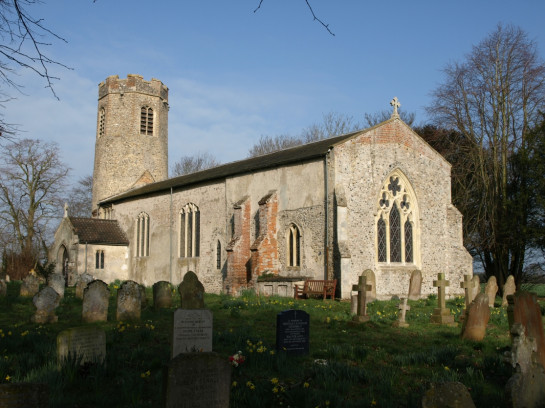History of St Catherine's Church

St Catherine lies up an unmade-up track (loke) in the midst of fields. In the past it has been lit and heated with calor gas and the walls became very damp and damaged. There is now electricity to the church and new heating and lighting is being installed; work will start on repairing the plaster on the walls. Despite evident work in progress people still come visiting even if it is not currently the oasis for peaceful meditation it usually is. We aim to have the work completed by June 2014. Anybody who feels moved to help fund this very expensive restoration is asked to email the treasurer via fritton@hempnallgroup.co.uk.
The church is mostly in the early Perpendicular style, but the north doorway (now leading to the vestry) is Norman. So, too, is the lower part of the round tower, though the upper section of the circular stage may be from the late l3th or early l4th century. The present octagonal belfry stage is probably l5th-century and the parapet is later still (perhaps l6th-century). There are three bells in the belfry dating from the reign of Edward VI (mid-l6th century).
The entrance arches of the porch have decorative heads. There is a holy water stoup is in the north-east corner, under a chamfered arch. The ancient south door, the main entrance to the church, was restored in 1619; the date and the initials of the churchwardens are carved along the central horizontal bar.
The fine rood screen (1510-1520) was given by John Bacon, who is shown with his wife and fourteen children on the far left-hand panels. On the north side are the four Latin Doctors: St Augustine, St Jerome, St Gregory and St Ambrose. St Gregory’s papal tiara has been scratched out. St Jerome’s cardinal’s hat, curiously, is still there. The right-hand panels portray St Simon (unfortunately his face is obliterated) and St Jude. In the spandrels are unicorns and St George facing up to the dragon. The screen was probably damaged by l6th-century Anglican reformers and/or by the Puritans in the l7th century. The present loft and rood were added in 1913 under the influence of the Oxford Movement.
The murals on the north wall were uncovered in 1850. They depict St George and St Christopher, the latter made at the expense of John Alward and his wife (1506). Under the will of John Alward certain lands were left in trust, with the income to be used primarily for the repair and maintenance of the church. The Rectors were required to say Mass and remember the benefactor annually on St Catherine's Day (25 November) - a practice that stopped at the Reformation. Two smaller murals were discovered in 1913, one possibly a representation of Archbishop Rich (mid l3th-century) and the other a consecration cross.

The l5th-century font is octagonal in style. LIke many fonts in East Anglia, it is decorated with lions and angels. Here, unusually, they are all grinning!
A recess in the north wall may once have been an Easter Sepulchre, where the Consecrated Host would be buried on Good Friday and carried back to the altar on Easter Day.
The roof dates from 1913. The vestry was added to the church in 1874. The oak lych-gate was the gift in 1879 of Mrs Irby of Boyland Hall
Church registers date from 1558, the earliest being a copy on vellum in the handwriting of Reginald Nuttall, Rector from 1577 to 1616.
(Images © Simon Knott, www.norfolkchurches.co.uk)
